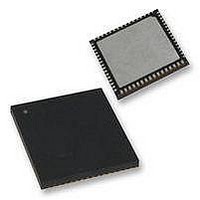PIC18F65K90-I/MR Microchip Technology, PIC18F65K90-I/MR Datasheet - Page 106

PIC18F65K90-I/MR
Manufacturer Part Number
PIC18F65K90-I/MR
Description
32kB Flash, 2kB RAM, 1kB EE, NanoWatt XLP, LCD 64 QFN 9x9x0.9mm TUBE
Manufacturer
Microchip Technology
Series
PIC® XLP™ 18Fr
Datasheet
1.PIC18F65K90-IMR.pdf
(570 pages)
Specifications of PIC18F65K90-I/MR
Processor Series
PIC18F
Core
PIC
Data Bus Width
8 bit
Program Memory Type
Flash
Program Memory Size
32 KB
Data Ram Size
2 KB
Interface Type
I2C, SPI
Maximum Clock Frequency
64 MHz
Number Of Timers
8
Operating Supply Voltage
1.8 V to 5.5 V
Maximum Operating Temperature
+ 125 C
3rd Party Development Tools
52715-96, 52716-328, 52717-734, 52712-325, EWPIC18
Minimum Operating Temperature
- 40 C
On-chip Adc
12 bit, 16 Channel
Core Processor
PIC
Core Size
8-Bit
Speed
64MHz
Connectivity
I²C, LIN, SPI, UART/USART
Peripherals
Brown-out Detect/Reset, LCD, POR, PWM, WDT
Number Of I /o
53
Eeprom Size
1K x 8
Ram Size
2K x 8
Voltage - Supply (vcc/vdd)
1.8 V ~ 5.5 V
Data Converters
A/D 16x12b
Oscillator Type
Internal
Operating Temperature
-40°C ~ 85°C
Package / Case
64-VFQFN Exposed Pad
Lead Free Status / Rohs Status
Details
- Current page: 106 of 570
- Download datasheet (5Mb)
PIC18F87K90 FAMILY
6.4.3.2
In addition to the INDF operand, each FSR register pair
also has four additional indirect operands. Like INDF,
these are “virtual” registers that cannot be indirectly
read or written to. Accessing these registers actually
accesses the associated FSR register pair, but also
performs a specific action on its stored value.
These operands are:
• POSTDEC – Accesses the FSR value, then
• POSTINC – Accesses the FSR value, then
• PREINC – Increments the FSR value by ‘1’, then
• PLUSW – Adds the signed value of the W register
In this context, accessing an INDF register uses the
value in the FSR registers without changing them.
Similarly, accessing a PLUSW register gives the FSR
value, offset by the value in the W register – with
neither value actually changed in the operation.
Accessing the other virtual registers changes the value
of the FSR registers.
Operations on the FSRs with POSTDEC, POSTINC
and PREINC affect the entire register pair. Rollovers of
the FSRnL register, from FFh to 00h, carry over to the
FSRnH register. On the other hand, results of these
operations do not change the value of any flags in the
STATUS register (for example, Z, N and OV bits).
The PLUSW register can be used to implement a form
of Indexed Addressing in the data memory space. By
manipulating the value in the W register, users can
reach addresses that are fixed offsets from pointer
addresses. In some applications, this can be used to
implement some powerful program control structure,
such as software stacks, inside of data memory.
DS39957D-page 106
automatically decrements it by ‘1’ afterwards
automatically increments it by ‘1’ afterwards
uses it in the operation
(range of -127 to 128) to that of the FSR and uses
the new value in the operation
FSR Registers and POSTINC,
POSTDEC, PREINC and PLUSW
6.4.3.3
Indirect Addressing operations that target other FSRs
or virtual registers represent special cases. For
example, using an FSR to point to one of the virtual
registers will not result in successful operations.
As a specific case, assume that the FSR0H:FSR0L
registers contain FE7h, the address of INDF1.
Attempts to read the value of the INDF1, using INDF0
as an operand, will return 00h. Attempts to write to
INDF1, using INDF0 as the operand, will result in a
NOP.
On the other hand, using the virtual registers to write to
an FSR pair may not occur as planned. In these cases,
the value will be written to the FSR pair, but without any
incrementing or decrementing. Thus, writing to INDF2
or POSTDEC2 will write the same value to the
FSR2H:FSR2L.
Since the FSRs are physical registers mapped in the
SFR space, they can be manipulated through all direct
operations. Users should proceed cautiously when
working on these registers, however, particularly if their
code uses Indirect Addressing.
Similarly, operations by Indirect Addressing are
generally permitted on all other SFRs. Users should
exercise the appropriate caution, so that they do not
inadvertently change settings that might affect the
operation of the device.
6.5
The operation of program memory is unaffected by the
use of the extended instruction set.
Enabling the extended instruction set adds five
additional two-word commands to the existing PIC18
instruction set: ADDFSR, CALLW, MOVSF, MOVSS and
SUBFSR. These instructions are executed as described
in
Section 6.2.4 “Two-Word
Program Memory and the
Extended Instruction Set
Operations by FSRs on FSRs
2009-2011 Microchip Technology Inc.
Instructions”.
Related parts for PIC18F65K90-I/MR
Image
Part Number
Description
Manufacturer
Datasheet
Request
R

Part Number:
Description:
Manufacturer:
Microchip Technology Inc.
Datasheet:

Part Number:
Description:
Manufacturer:
Microchip Technology Inc.
Datasheet:

Part Number:
Description:
Manufacturer:
Microchip Technology Inc.
Datasheet:

Part Number:
Description:
Manufacturer:
Microchip Technology Inc.
Datasheet:

Part Number:
Description:
Manufacturer:
Microchip Technology Inc.
Datasheet:

Part Number:
Description:
Manufacturer:
Microchip Technology Inc.
Datasheet:

Part Number:
Description:
Manufacturer:
Microchip Technology Inc.
Datasheet:

Part Number:
Description:
Manufacturer:
Microchip Technology Inc.
Datasheet:










